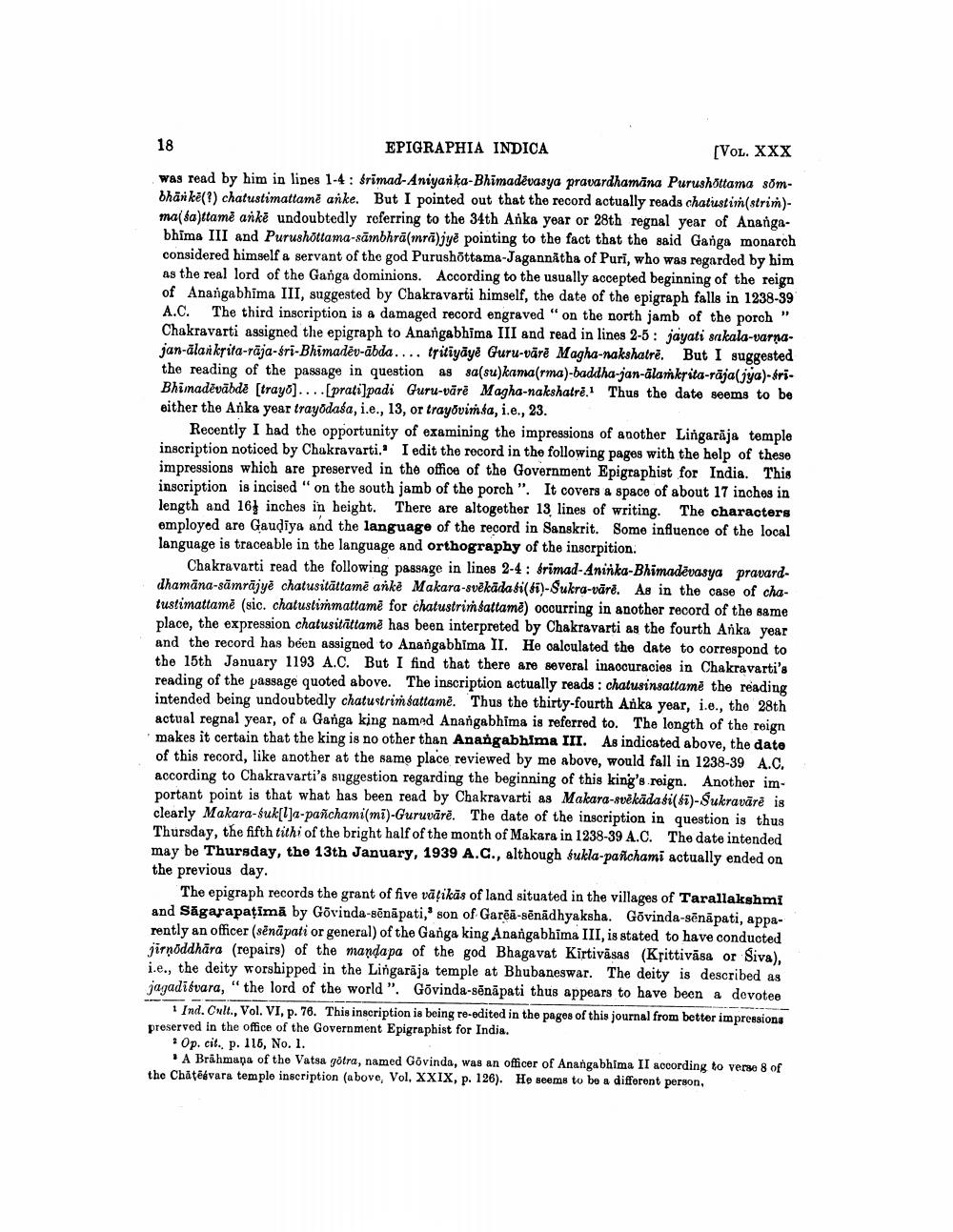________________
EPIGRAPHIA INDICA
[VOL. XXX was read by him in lipes 1-4 : Srimad-Aniyarika-Bhimadevasya pravardhamāna Purushottama sombhari kë(?) chatustimattamë anke. But I pointed out that the record actually reads chatustim(strin)mal ša)ttamë ankė undoubtedly referring to the 34th Anka year or 28th regnal year of Anangabhima III and Purushottama-sāmbhrā(mr)jyë pointing to the fact that the said Ganga monarch considered himself a servant of the god Purushottama-Jagannåtha of Puri, who was regarded by him as the real lord of the Ganga dominions. According to the usually accepted beginning of the reign of Anangabhima III, suggested by Chakravarti himself, the date of the epigraph falls in 1238-39 A.C. The third inscription is a damaged record engraved" on the north jamb of the porch" Chakravarti assigned the epigraph to Anangabhima III and read in lines 2-5: jayati sakala-varnajan-ālai krita-raja-fri-Bhimadēv-ābda.... tritiyāye Guru-vārē Magha-nakshatrē. But I suggested the reading of the passage in question as sa(su)kama(rma)-baddha-jan-ālamkrita-rāja(jya)-triBhimadēvābde (trayo)....(prati]padi Guru-vārė Magha-nakshatre. Thus the date seems to be either the Anka year trayodasa, i.e., 13, or trayovima, i.e., 23.
Recently I had the opportunity of examining the impressions of another Lingaraja temple inscription noticed by Chakravarti.I edit the record in the following pages with the help of these impressions which are preserved in the office of the Government Epigraphist for India. This inscription is incised "on the south jamb of the porch ". It covers a space of about 17 inches in length and 164 inches in height. There are altogether 13 lines of writing. The characters employed are Gaudiya and the language of the record in Sanskrit. Some influence of the local language is traceable in the language and orthography of the insorption.
Chakravarti read the following passage in lines 2-4 : Srimad-Aninka-Bhimadēvasya pravarddhamāna-sämrajye chatusitāttamë anke Makara-svēkāda bi( fi)-Sukra-värd. As in the case of chatustimattamë (sic. chatustimmattame for chatustrimsattame) occurring in another record of the same place, the expression chatusitāttame has been interpreted by Chakravarti as the fourth Arka year and the record has been assigned to Anangabhima II. He calculated the date to correspond to the 15th January 1193 A.C. But I find that there are several inaccuracies in Chakravarti's reading of the passage quoted above. The inscription actually reads : chatusinsattame the reading intended being undoubtedly chatustrimsattamē. Thus the thirty-fourth Anka year, i.e., the 28th actual regnal year, of a Ganga king namad Anangabhima is referred to. The longth of the reign makes it certain that the king is no other than Anangabhima III. As indicated above, the date of this record, like another at the same place reviewed by me above, would fall in 1238-39 A.C. according to Chakravarti's suggestion regarding the beginning of this king's reign. Another important point is that what has been read by Chakravarti as Makara-svěkādasi(67)-Sukravāre is clearly Makara-suk[l]a-pañchami(mi)-Guruvärē. The date of the inscription in question is thus Thursday, the fifth tithi of the bright half of the month of Makara in 1238-39 A.C. The date intended may be Thursday, the 13th January, 1939 A.C., although sukla-panchami actually ended on the previous day.
The epigraph records the grant of five vātikās of land situated in the villages of Tarallakshmi and Sāgarapatima by Govinda-Bēnāpati, son of Garēã-sënádhyaksha. Govinda-sēnā pati, apparently an officer (sënāpati or general) of the Ganga king Anangabhima III, is stated to have conducted jirnoddhāra (repairs) of the manda pa of the god Bhagavat Kirtivāsas (Krittiväsa or Siva), i.e., the deity worshipped in the Lingarāja temple at Bhubaneswar. The deity is described as jagadisvara, "the lord of the world". Govinda-sēnāpati thus appears to have been a devotee
1 Ind. Cult., Vol. VI, p. 76. This inscription is being re-edited in the pages of this journal from better impressions preserved in the office of the Government Epigraphist for India.
* Op. cit. p. 116, No. 1.
A Brahmapa of the Vatsa götra, named Govinda, was an officer of Anangabhima Il according to verse 8 of the Chātēsvara temple inscription (above, Vol. XXIX, p. 126). He seems to be a different person,




